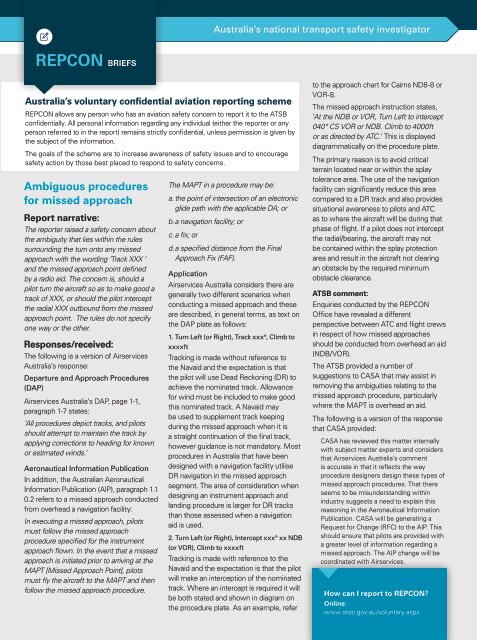jul-aug2012
Create successful ePaper yourself
Turn your PDF publications into a flip-book with our unique Google optimized e-Paper software.
REPCON BRIEFS<br />
Australia’s voluntary confidential aviation reporting scheme<br />
REPCON allows any person who has an aviation safety concern to report it to the ATSB<br />
confidentially. All personal information regarding any individual (either the reporter or any<br />
person referred to in the report) remains strictly confidential, unless permission is given by<br />
the subject of the information.<br />
The goals of the scheme are to increase awareness of safety issues and to encourage<br />
safety action by those best placed to respond to safety concerns.<br />
Ambiguous procedures<br />
for missed approach<br />
Report narrative:<br />
The reporter raised a safety concern about<br />
the ambiguity that lies within the rules<br />
surrounding the turn onto any missed<br />
approach with the wording ‘Track XXX ‘<br />
and the missed approach point defined<br />
by a radio aid. The concern is, should a<br />
pilot turn the aircraft so as to make good a<br />
track of XXX, or should the pilot intercept<br />
the radial XXX outbound from the missed<br />
approach point. The rules do not specify<br />
one way or the other.<br />
Responses/received:<br />
The following is a version of Airservices<br />
Australia’s response:<br />
Departure and Approach Procedures<br />
(DAP)<br />
Airservices Australia’s DAP, page 1-1,<br />
paragraph 1-7 states:<br />
‘All procedures depict tracks, and pilots<br />
should attempt to maintain the track by<br />
applying corrections to heading for known<br />
or estimated winds.’<br />
Aeronautical Information Publication<br />
In addition, the Australian Aeronautical<br />
Information Publication (AlP), paragraph 1.1<br />
0.2 refers to a missed approach conducted<br />
from overhead a navigation facility:<br />
In executing a missed approach, pilots<br />
must follow the missed approach<br />
procedure specified for the instrument<br />
approach flown. In the event that a missed<br />
approach is initiated prior to arriving at the<br />
MAPT [Missed Approach Point], pilots<br />
must fly the aircraft to the MAPT and then<br />
follow the missed approach procedure.<br />
The MAPT in a procedure may be:<br />
a. the point of intersection of an electronic<br />
glide path with the applicable DA; or<br />
b. a navigation facility; or<br />
c. a fix; or<br />
d. a specified distance from the Final<br />
Approach Fix (FAF).<br />
Application<br />
Airservices Australia considers there are<br />
generally two different scenarios when<br />
conducting a missed approach and these<br />
are described, in general terms, as text on<br />
the DAP plate as follows:<br />
1. Turn Left (or Right), Track xxx°, Climb to<br />
xxxxft<br />
Tracking is made without reference to<br />
the Navaid and the expectation is that<br />
the pilot will use Dead Reckoning (DR) to<br />
achieve the nominated track. Allowance<br />
for wind must be included to make good<br />
this nominated track. A Navaid may<br />
be used to supplement track keeping<br />
during the missed approach when it is<br />
a straight continuation of the final track,<br />
however guidance is not mandatory. Most<br />
procedures in Australia that have been<br />
designed with a navigation facility utilise<br />
DR navigation in the missed approach<br />
segment. The area of consideration when<br />
designing an instrument approach and<br />
landing procedure is larger for DR tracks<br />
than those assessed when a navigation<br />
aid is used.<br />
2. Turn Left (or Right), Intercept xxx° xx NDB<br />
(or VOR), Climb to xxxxft<br />
Tracking is made with reference to the<br />
Navaid and the expectation is that the pilot<br />
will make an interception of the nominated<br />
track. Where an intercept is required it will<br />
be both stated and shown in diagram on<br />
the procedure plate. As an example, refer<br />
to the approach chart for Cairns ND8-8 or<br />
VOR-8.<br />
The missed approach instruction states,<br />
‘At the NDB or VOR, Turn Left to intercept<br />
040° CS VOR or NDB. Climb to 4000ft<br />
or as directed by ATC.’ This is displayed<br />
diagrammatically on the procedure plate.<br />
The primary reason is to avoid critical<br />
terrain located near or within the splay<br />
tolerance area. The use of the navigation<br />
facility can significantly reduce this area<br />
compared to a DR track and also provides<br />
situational awareness to pilots and ATC<br />
as to where the aircraft will be during that<br />
phase of flight. If a pilot does not intercept<br />
the radial/bearing, the aircraft may not<br />
be contained within the splay protection<br />
area and result in the aircraft not clearing<br />
an obstacle by the required minimum<br />
obstacle clearance.<br />
ATSB comment:<br />
Enquiries conducted by the REPCON<br />
Office have revealed a different<br />
perspective between ATC and flight crews<br />
in respect of how missed approaches<br />
should be conducted from overhead an aid<br />
(NDB/VOR).<br />
The ATSB provided a number of<br />
suggestions to CASA that may assist in<br />
removing the ambiguities relating to the<br />
missed approach procedure, particularly<br />
where the MAPT is overhead an aid.<br />
The following is a version of the response<br />
that CASA provided:<br />
CASA has reviewed this matter internally<br />
with subject matter experts and considers<br />
that Airservices Australia’s comment<br />
is accurate in that it reflects the way<br />
procedure designers design these types of<br />
missed approach procedures. That there<br />
seems to be misunderstanding within<br />
industry suggests a need to explain this<br />
reasoning in the Aeronautical Information<br />
Publication. CASA will be generating a<br />
Request for Change (RFC) to the AlP. This<br />
should ensure that pilots are provided with<br />
a greater level of information regarding a<br />
missed approach. The AlP change will be<br />
coordinated with Airservices.<br />
How can I report to REPCON?<br />
Online:<br />
www.atsb.gov.au/voluntary.aspx

















